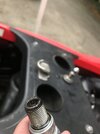sticknrudder
New Member
I just finished winterizing my 2001 GTX and I pulled the plugs to spray fogging oil in the cylinders to find water on the plugs. Did I do something wrong when I winterized? I wish I had checked the plugs before pouring antifreeze in the head. The way I winterized it was pinched the outflow hose at the bottom off the engine and gravity fed anti freeze into the water inlet on the head. I did this until antifreeze came out of the exhaust. I never started it. Anything I did wrong?
Thanks
Thanks




